World Rally Championship
The World Rally Championship (WRC) is a rallying series organised by the FIA, culminating with a champion driver, co-driver and manufacturer. The driver's world championship and manufacturer's world championship are separate championships, but based on the same point system. The series currently consists of 14 three-day events driven on surfaces ranging from gravel and tarmac to snow and ice. Each rally is usually split into 15–25 special stages which are run against the clock on closed roads.[1]
 | |
| Category | World Rally Car |
|---|---|
| Country | International |
| Inaugural season | 1973 |
| Manufacturers | 3 |
| Tire suppliers | M, P |
| Drivers' champion | |
| Co-Drivers' champion | |
| Constructors' champion | |
| Official website | www |
| World Rally Championship |
|---|
| Current season |
| Classes of competition |
| Support categories |
|
Current:
|
| Related lists |
The WRC was formed from well-known and popular international rallies, most of which had previously been part of the European Rally Championship or the International Championship for Manufacturers, and the series was first contested in 1973. The World Rally Car is the current car specification in the series. It evolved from Group A cars which replaced the banned Group B supercars. World Rally Cars are built on production 1.6-litre four-cylinder cars, but feature turbochargers, anti-lag systems, four-wheel-drive, sequential gearboxes, aerodynamic parts and other enhancements bringing the price of a WRC car to around US$1 million (€700,000 / £500,000).[2]
The WRC features three support championships, the Junior World Rally Championship (JWRC, formerly the WRC Academy), the World Rally Championship-2, and the World Rally Championship-3 which are contested on the same events and stages as the WRC, but with different regulations. The WRC-2, WRC-3 and junior entrants race through the stages after the WRC drivers.
History
Early

The World Rally Championship was formed from well-known international rallies, nine of which were previously part of the International Championship for Manufacturers (IMC), which was contested from 1970 to 1972. The 1973 World Rally Championship was the inaugural season of the WRC and began with the Monte Carlo Rally on January 19.
Alpine-Renault won the first manufacturer's world championship with its Alpine A110, after which Lancia took the title three years in a row with the Ferrari V6-powered Lancia Stratos HF, the first car designed and manufactured specifically for rallying. The first drivers' world championship was not awarded until 1979, although 1977 and 1978 seasons included an FIA Cup for Drivers, won by Italy's Sandro Munari and Finland's Markku Alén respectively. Sweden's Björn Waldegård became the first official world champion, edging out Finland's Hannu Mikkola by one point. Fiat took the manufacturers' title with the Fiat 131 Abarth in 1977, 1978 and 1980, Ford with its Escort RS1800 in 1979 and Talbot with its Sunbeam Lotus in 1981. Waldegård was followed by German Walter Röhrl and Finn Ari Vatanen as drivers' world champions.
Group B era
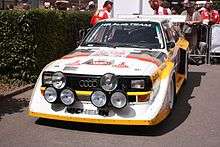
The 1980s saw the rear-wheel-drive Group 2 and the more popular Group 4 cars be replaced by more powerful four-wheel-drive Group B cars. FISA legalized all-wheel-drive in 1979, but most manufacturers believed it was too complex to be successful. However, after Audi started entering Mikkola and the new four-wheel-drive Quattro in rallies for testing purposes with immediate success, other manufacturers started their all-wheel-drive projects. Group B regulations were introduced in the 1982, and with only a few restrictions allowed almost unlimited power. Audi took the constructors' title in 1982 and 1984 and drivers' title in 1983 (Mikkola) and 1984 (Stig Blomqvist). Audi's French female driver Michèle Mouton came close to winning the title in 1982, but had to settle for second place after Opel rival Röhrl. 1985 title seemed set to go to Vatanen and his Peugeot 205 T16 but a bad accident at the Rally Argentina left him to watch compatriot and teammate Timo Salonen take the title instead. Italian Attilio Bettega had even a more severe crash with his Lancia 037 at the Tour de Corse and died instantly.

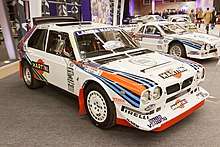
The 1986 started with impressive performances by Finns Henri Toivonen and Alén in Lancia's new turbo- and supercharged Delta S4, which could reportedly accelerate from 0–60 mph (96 km/h) in 2.3 seconds, on a gravel road.[3] However, the season soon took a dramatic turn. At the Rally Portugal, three spectators were killed and over 30 injured after Joaquim Santos lost control of his Ford RS200. At the Tour de Corse, championship favourite Toivonen and his co-driver Sergio Cresto died in a fireball accident after plunging down a cliff. Only hours after the crash, Jean-Marie Balestre and the FISA decided to freeze the development of the Group B cars and ban them from competing in 1987. More controversy followed when Peugeot's Juha Kankkunen won the title after FIA annulled the results of the San Remo Rally, taking the title from fellow Finn Markku Alén.
Group A era
.jpg)
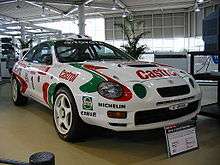

As the planned Group S was also cancelled, Group A regulations became the standard in the WRC until 1997. A separate Group A championship had been organized as part of the WRC already in 1986, with Sweden's Kenneth Eriksson taking the title with a Volkswagen Golf GTI 16V.[4] Lancia was quickest in adapting to the new regulations and controlled the world rally scene with Lancia Delta HF, winning the constructors' title six years in a row from 1987 to 1992 and remains the most successful marque in the history of the WRC. Kankkunen and Miki Biasion both took two drivers' titles with the Lancia Delta HF. The 1990s then saw the Japanese manufacturers, Toyota, Subaru and Mitsubishi, become title favourites. Spain's Carlos Sainz driving for Toyota Team Europe took the 1990 and 1992 titles with a Toyota Celica GT-Four. Kankkunen moved to Toyota for the 1993 season and won his record fourth title, with Toyota taking its first manufacturers' crown. Frenchman Didier Auriol brought the team further success in 1994, and soon Subaru and Mitsubishi continued the success of the Japanese constructors. Subaru's Scotsman Colin McRae won the drivers' world championship in 1995 and Subaru took the manufacturers' title three years in a row. Finland's Tommi Mäkinen driving a Mitsubishi Lancer Evolution won the drivers' championship four times in a row, from 1996 to 1999. Mitsubishi also won the manufacturers' title in 1998. Another notable car was the Ford Escort RS Cosworth, which was specifically designed for rallying. It was the first production car to produce downforce both at front and rear.
World Rally Car era
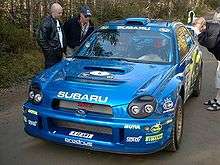

For the 1997 World Rally Championship, the World Rally Car regulations were introduced as an intended replacement for Group A (only successive works Mitsubishis still conforming to the latter formula; until they, too, homologated a Lancer Evolution WRC from the 2001 San Remo Rally). After the success of Mäkinen and the Japanese manufacturers, France's Peugeot made a very successful return to the World Rally Championship. Finn Marcus Grönholm took the drivers' title in his first full year in the series and Peugeot won the manufacturers' crown. England's Richard Burns won the 2001 title with a Subaru Impreza WRC, but Grönholm and Peugeot took back both titles in the 2002. 2003 saw Norway's Petter Solberg become drivers' champion for Subaru and Citroën continue the success of the French manufacturers. Citroën's Sébastien Loeb went on to control the following seasons with his Citroën Xsara WRC. Citroën took the constructors' title three times in a row and Loeb surpassed Mäkinen's record of four consecutive drivers' titles, earning his ninth consecutive championship in 2012. Volkswagen Motorsport entered the championship in 2013 and Sebastien Ogier dominated the series with six consecutive titles. New World Rally Car rules were introduced for 2017 which generated faster and more aggressive cars.
In 2018, Toyota Gazoo Racing WRT won the World Rally Championship earning Toyota their first manufacturers' title since 1999.[5] With Tommi Mäkinen heading the team, he became the first person in the history of rally driving to win a Championship both as a driver and as a team principal.[6]
Structure
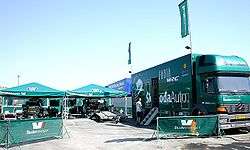
Each season normally consists of 13 rallies driven on surfaces ranging from gravel and tarmac to snow and ice. Points from these events are calculated towards the drivers' and manufacturers' world championships. The driver's championship and manufacturer's championship are separate championships, but based on the same point system. This means, for example, that Petter Solberg driving for Subaru can win the driver's championship but Citroën can win the manufacturer's championship, which is what happened in 2003, and again in 2006 and 2007 when Sébastien Loeb took his third and fourth WRC titles but Ford won the manufacturer's championship.
Under the current points system, points are awarded at the end of each rally to the top ten overall finishers in the World Rally Championship standings, as well as to the top ten finishers within the Super 2000 and Production Car (also known as WRC 2), two-wheel drive (also known as WRC 3) and Junior World Rally Championships. All categories use the following points structure:
| Position | 1st | 2nd | 3rd | 4th | 5th | 6th | 7th | 8th | 9th | 10th |
|---|---|---|---|---|---|---|---|---|---|---|
| Points | 25 | 18 | 15 | 12 | 10 | 8 | 6 | 4 | 2 | 1 |
Despite how many drivers are in one team, constructors may only nominate two drivers to score points for the team as well as scoring for themselves. As only nominated drivers are counted while awarding points, competitors placed further down the final standings than tenth overall (if preceded by privateer drivers) can score them.
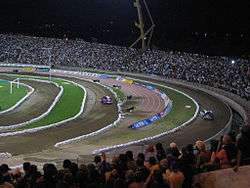
In the current era, each rally usually consists of between fifteen and thirty special stages of distances ranging from under 2 km (1.2 mi) (known as super special stages) to over 50 kilometres (31 mi). These competitive stages are driven on closed roads which are linked by non-competitive road sections—open roads on which all road laws of that country must be adhered to. On average a day consists of a total of 400 kilometres (250 mi) of driving.[7] A WRC event begins with reconnaissance (recce) on Tuesday and Wednesday, allowing crews to drive through the stages and create or update their pace notes. On Thursday, teams can run through the shakedown stage to practice and test their set-ups. The competition typically begins on Friday and ends on Sunday, though some rallies—most notably the Monte Carlo Rally—may be run over four or five days. Cars start the stages at two-minute intervals in clear weather, or three-minute intervals if it is decided that visibility may be a problem for competitors. Each day, or leg, has a few designated service parks between the stages, where the teams can – within strict time limits – perform maintenance and repairs on their cars. The service park also allows spectators and the media to get close to the teams and their cars and drivers. Between the days, after a 45-minute end of day service, cars are locked away in parc fermé,[7] a quarantine environment where teams are not permitted to access or work on their cars.
Power Stage
First introduced in 2011, the "Power Stage" is the final stage of the rally. Additional World Championship points are available to the three (until 2016) fastest drivers through the stage (regardless of where they actually finished in the rally), with the fastest team receiving three points, the second-fastest receiving two points, and the third-fastest receiving one point. In 2017 the scoring system was amended so the five fastest drivers through the stage were awarded points from five for first to one for fifth. For special stages, timing will be to the tenth of a second. For the "Power Stage", timing will be to the thousandth of a second.[8]
Rally 2
Originally known as "SuperRally," Rally 2 is a set of regulations that allow a driver who retires from an event to re-enter the next day at the cost of a seven-minute time penalty for each missed stage (ten-minute penalty if only one stage is missed). This allows drivers who retire from an event to continue on and compete for World Championship points; however, if they retire on the final leg of a rally, re-entering is not possible. Similarly, the use of Rally 2 regulations is at the discretion of event organisers.
Cars

The current cars with 1.6 L direct injection turbo engines and four-wheel drive are built to World Rally Car regulations for racing across tarmac, gravel and snow. The power output is limited to around 380 bhp (280 kW). Current cars in the championship include the Citroën C3 WRC, Ford Fiesta WRC, Toyota Yaris WRC and the Hyundai i20 Coupe WRC. The Volkswagen Polo R WRC ended its run with the close of the 2016 season.[9]
The WRC was formerly held for Group A and Group B rallycars. However, due to the increasing power, lack of reliability and a series of fatal accidents during the 1986 rally, Group B was permanently banned. Later, in 1997, the Group A cars evolved into the WRC car spec, to ease the development of new cars and bring new makes to the competition. In 2011, new rules were introduced to encourage more manufacturers (and privateers) to take part, because the recent economic downturn had prompted several manufacturers to leave the championship.
Cars in the Production Car World Rally Championship are limited to production-based cars homologated under Group N rules. Cars in the Super 2000 World Rally Championship are homologated under Super 2000 rules. Most cars in the Junior World Rally Championship are homologated under Super 1600 rules, but Group N and selected Group A cars can also contest the series.
Starting in 2013, a new category of rally cars known as Group R were introduced as a replacement to the Group A and Group N rally categories, with cars classified under one of six categories based on their engine capacity and type, wheelbase, and drivetrain. As a result, no cars will be homologated under Group A and Group N regulations and instead will be reclassified under Group R. Parallel to this, the Super 2000 and Production Car World Championships were restructured; Super 2000 and Group N cars were merged into a single championship known as World Rally Championship-2 alongside R4 and R5 cars, whilst the Production Car World Championship was completely reimagined as the World Rally Championship-3 for two-wheel drive cars complying with R1, R2 and R3 regulations.
Teams and drivers

21 different manufacturers have won a World Rally Championship event: Citroën, Ford, Lancia, Toyota, Peugeot, Subaru, Volkswagen, Mitsubishi, Audi, Fiat, Hyundai, Datsun/Nissan, Opel, Renault, Renault-Alpine, Saab, Mazda, BMW, Mercedes-Benz, Porsche and Talbot.[10] Further 11 have finished on the podium: Seat, Mini, Vauxhall, Alfa Romeo, Volvo, Ferrari, MG, Polski Fiat, Škoda, Triumph and Wartburg.[11]
Suzuki and Subaru pulled out of the WRC at the end of the 2008 championship, both citing the economic downturn then affecting the automotive industry for their withdrawal. Mini and Ford both pulled out of the WRC at the end of the 2012 championship, due to a similar economic downturn affecting the European market, although Ford continued to give technical support to M-Sport.
A typical WRC team will consist of about 40 people on the events, with a further 60–100 at the team base.[12]
Manufacturers and manufacturer-backed teams usually have two or three drivers participating in each rally who are eligible to score points. The total number of crews (driver and their co-driver) in the rallies varied from 47 (Monte Carlo and Mexico) to 108 (Great Britain) during the 2007.[13]
In 2012, the Ford World Rally Team and the Mini WRC Team both announced their departure from the World Rally Championships for the 2013 season. Volkswagen and Hyundai made their return to the championship in 2013 and 2014, respectively. Toyota announced it will return to the World Rally Championships for the 2017 season[14] with its Toyota Gazoo Racing team and its Toyota Yaris WRC car. Also Citroën will return to the sport in 2017 with a fully factory-supported team after competing part-time in 2016 to focus on the development of their 2017-generation brand-new car based on the Citroën C3.
Coverage
TV
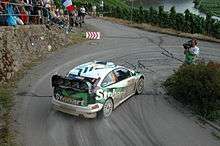
WRC Promoter GmbH owns the commercial rights to the championship and through WRC TV produces daily updates from each event after the day's stages have finished and the TV coverage has been processed. These daily highlight programs are 30 minutes in duration and cover in depth the day's stages, with in-car footage as well as driver interviews. Before the rally there is also a magazine-style preview programme that normally incorporates special driver, technical and team features as well as providing an overview of the upcoming rally's route. There is also a post-event review program, which lasts approximately an hour, that summarises the rally and the big events that took place during the event.
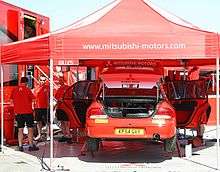
This is then shown in more than 150 markets in multiple languages. The make up and format for these programmes can change from country to country depending on the local broadcaster but all use WRC TV.
In the United Kingdom, coverage of the 2017 season is split between four broadcasters. Channel 5 broadcasts the post-event review, while the preview programme is screened on its Spike network. BT Sport has rights to live stages and daily highlights, Motors TV has highlights rights and Welsh language channel S4C also covers the championship in its Ralio programme.[15]
In 2016, the cumulative worldwide TV audience for WRC TV's programmes was more than 700 million. The programming was available in over 150 markets and more than 12,000 hours were screened globally.[16]
Radio
Live radio coverage was provided in English by WRC Live via the Internet, featuring end of stage reports direct from the drivers and teams plus service park news. They also produced podcasts. It also featured contemporary music during breaks in rally coverage.[17]
Currently the radio plays the sound of WRC+ All Live.[18]
Internet streaming
Coverage is provided by WRC Promoter GmbH via video on demand at its WRC+ website featuring live special stages, highlights, timing, onboard footage and live map tracking.[19]
From 2018, WRC+ All Live was introduced, producing live coverage from all the stages during rally event.[19]
Champions


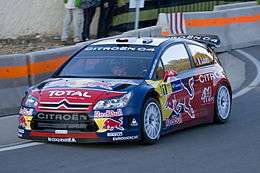
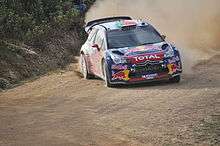
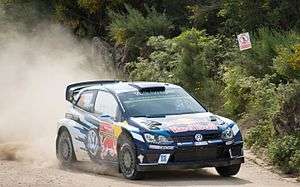
Event wins
Updated after 2020 Rally Mexico. Drivers and manufacturers who have participated in the 2020 World Rally Championship are in bold.
|
|
|
Evolution of the calendar
Other classes

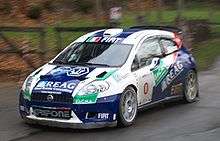
The World Rally Championship also features support championships called the World Rally Championship-2 (previously known as S-WRC), the World Rally Championship-3 (previously known as P-WRC) and the Junior World Rally Championship (J-WRC). These championships are contested on the same events and stages as the WRC.
The Super 2000 World Rally Championship (S-WRC) was started in 2010. Within the Super 2000 category are competitions for drivers (known as the S-WRC) and another for teams (the World Rally Championship Cup). The cars in the championship are under the Super 2000 rules.[28] From 2013, WRC-2 replaced S-WRC and including cars with four-wheel drive (R5, R4 and S2000).[29][30]
The Production car World Rally Championship (P-WRC) began in 2002, replacing the FIA Group N Cup which had been contested from 1987. Cars in the championship are production-based and homologated under Group N rules.[31] From 2013, the Production WRC was renamed WRC-3 including Group R cars with two-wheel drive (R3, R2 and R1).[29][30] By the end of 2018, the World Rally Championship-3 was discontinued and a new class was created within the World Rally Championship-2. The class, known as World Rally Championship-2 Pro, is open to manufacturer-supported teams entering cars complying with Group R5 regulations.[32]
The Junior World Rally Championship (J-WRC) was started in 2001, and can be contested with Super 1600, Group N and selected Group A cars. Drivers in the championship have to be 28 years or younger. There is no age limit for co-drivers.[33]
The World Rally Championship Ladies Cup ran from 1990 to 1995 and could be won by any class of car. Louise Aitken-Walker was the first winner.[34]
| Class | WRC | WRC-2, WRC-3 | JWRC | Other |
|---|---|---|---|---|
| Group | WRC+ | R5, R4 | R2 | R1, R3, S2000, S1600, R-GT |
| Drivetrain | Four-wheel drive | Two-wheel drive | ||
| Minimum weight (kg) | 1175 | 1230/1230 | 1030 | |
| Typical power (hp) | 380 | 300/260 | 185 | |
| Torque (N⋅m) | 450 | 420/390 | 190 | |
Video games
There have been many video games based on the World Rally Championship, and due to lack of licenses, many more based on only certain cars, drivers or events. Sega Rally was released in 1995, V-Rally and Top Gear Rally in 1997 and the first game in the very popular Colin McRae Rally series in 1998. Rally Trophy, released in 2001 for Microsoft Windows by Bugbear, concentrated on historic cars such as Alpine A110 and Lancia Stratos. RalliSport Challenge, released in 2002 for Windows and Xbox by Digital Illusions CE, featured classic Group B cars and hillclimb models along with modern WRC cars.
Fully FIA licensed WRC: World Rally Championship was released in 2001 for PlayStation 2 by Evolution Studios. The video game series had its fifth game, WRC: Rally Evolved, in 2005. Racing simulator Richard Burns Rally, released in 2004 for several platforms, has gathered recognition for its realism. Recent top-selling games include Colin McRae: DiRT 2, Sega Rally Revo and Dirt 3. Gran Turismo 5 includes WRC licensed cars from manufacturers such as Subaru and Ford. In October 2010, Black Bean Games released WRC: FIA World Rally Championship which features the cars, drivers and events of the 2010 World Rally Championship, including those from the three support categories. A downloadable patch was produced allowing players to drive in Group B cars such as the Audi Quattro.[35] Various cars whose participated in the WRC such as Mitsubishi Lancer WRC and Ford Fiesta RS WRC have also appeared in the Facebook game Car Town. The WRC video game license was acquired by French game development studio Kylotonn from Milestone srl after the release of WRC 4: FIA World Rally Championship in 2013. The first WRC game by Kylotonn was WRC 5, released in 2015. This was followed by WRC 6 in 2016, WRC 7 in 2017 and WRC 8 in 2019. The latest release, WRC 9 will be released September 3. .
Footnotes
- M-Sport is not the official Ford World Rally Team.
- Ford competed from 1973–1985 with a U.S. racing license, and has competed since 1986 with a British racing licence.[20]
- Björn Waldegård drove a Mercedes 450 SLC in two rallies in 1979.
- In 1977 and 1978, the drivers championship was the FIA Cup for Rally Drivers.
- Markku Alén drove a Lancia Stratos HF in two rallies in 1978.
- No drivers title 1973–1976.
- Valid only for 2 Litres Cup
- The rally was cancelled during the season.[24]
- From 1982 to 1992 valid only for driver championship.
- The rally was cancelled during the season.[25]
- The rally was cancelled during the season.[26]
- The rally was cancelled before the season.[27]
References
- "What is WRC?". WRC.com. Retrieved 2018-09-20.
- "What is WRC? – The cars". WRC.com. Archived from the original on 2009-07-03. Retrieved 2008-08-28.
- Biggs, Henry. "Top 10: Group B rally cars". MSN Cars UK. Archived from the original on 2011-08-09. Retrieved 2007-12-18.
- "World Rally Championship for Drivers Champions". RallyBase. Retrieved 2007-12-21.
- Van Leeuwen, Andrew (18 November 2018). "Rally Australia: Latvala wins as Ogier, Toyota claim WRC titles". autosport.com. Motorsport Network. Retrieved 8 December 2018.
- "Tommi Mäkinen on rallin Midas – näin Puuppolan päälliköstä tuli historiallinen maailmanmestari Toyotan tallipäällikkönä". Aamulehti (in Finnish). 18 November 2018. Retrieved 8 December 2018.
- "What is WRC?". Rally Ireland. Archived from the original on 2015-04-21. Retrieved 2008-08-28.
- "- Federation Internationale de l'Automobile".
- "Volkswagen Confirms It's Quitting the World Rally Championship". 2 November 2016.
- "Make wins". World Rally Archive. Retrieved 2018-05-02.
- "Make podium finishes". World Rally Archive. Retrieved 2018-05-02.
- "The service park". Rally Ireland. Archived from the original on 2008-12-01. Retrieved 2008-08-30.
- "Season 2007 event statistics". World Rally Archive. Retrieved 2008-08-30.
- "Microsoft and Toyota join forces in FIA World Rally Championship". Retrieved 2016-10-22.
- http://www.s4c.cymru/en/sport/ralio/
- "WRC Factbook 16-17". www.wrc.com.
- https://rallysportmag.com/popular-rally-radio-service-to-end-after-tour-de-corse/
- https://www.wrc.com/live-ticker/live_popup_radio.html
- https://plus.wrc.com
- "Ford Manufacturer Profile & Rally History". rally-info.com. Retrieved 16 December 2018.
- "Statistics - Driver wins". juwra.com.
- "Statistics - Driver wins per nationalities". juwra.com.
- "Statistics - Makes wins". juwra.com.
- "WRC sets return date". wrc.com. WRC Promoter GmbH. 2 July 2020. Retrieved 2 July 2020.
- "Rally Australia Cancelled". www.wrc.com. Retrieved November 12, 2019.
- "Rally China cancelled due to weather damage - wrc.com". www.wrc.com. Retrieved August 16, 2018.
- Evans, David (29 November 2019). "WRC's 2020 Rally Chile cancelled due to political and social unrest". autosport.com. Motorsport Network. Retrieved 30 November 2019.
- "World Rally Championship". Wrc.com. Archived from the original on 2010-01-21. Retrieved 2010-07-31.
- "Exciting changes for 2013 WRC". www.nesterallyfinland.fi.
- "Rally – Exciting Changes in WRC for 2013". 29 September 2012.
- "FIA Production car World Rally Championship". WRC.com. Archived from the original on 2008-12-01. Retrieved 2007-01-26.
- Herrero, Daniel (13 October 2018). "Australia remains finale on 2019 WRC calendar". speedcafe.com. Speedcafe. Retrieved 13 October 2018.
- "FIA Junior Rally Championship". WRC.com. Archived from the original on 2008-12-01. Retrieved 2007-01-26.
- "rallybase.nl". rallybase.nl. Retrieved 2011-10-14.
- "WRC the game, the official videogame of the 2010 FIA World Rally Championship, hits the shelves today!". RallyBuzz. 8 October 2010. Retrieved 29 October 2010.
External links
| Wikimedia Commons has media related to World Rally Championship. |
- News and information
- WRC.com — official site
- World Rally Championship regulations fia.com
- Results
- eWRC-results.com — complex and up-to-date results database
- juwra.com – World Rally Archive — database and statistics